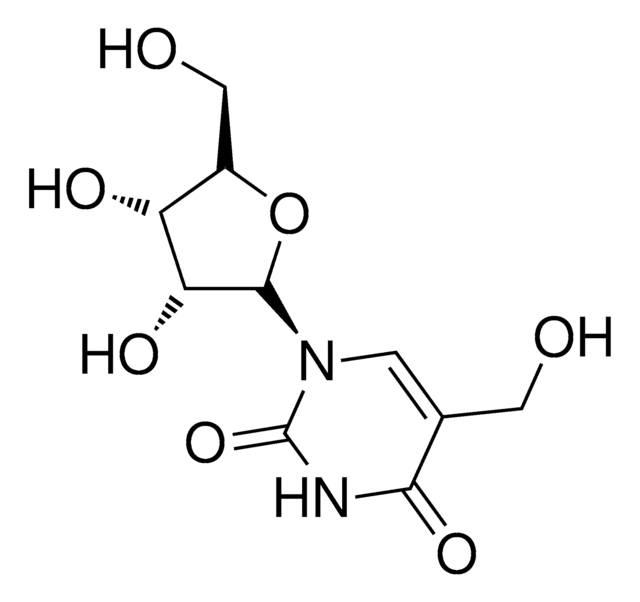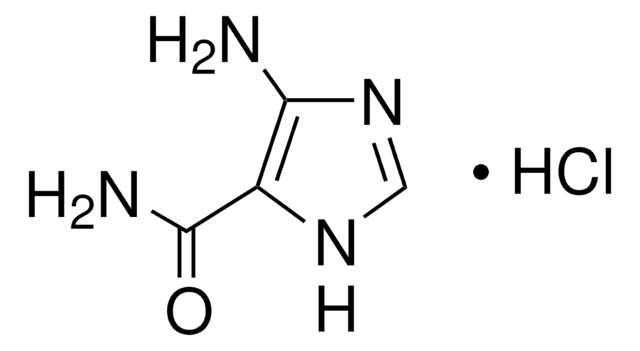All Photos(1)
About This Item
Empirical Formula (Hill Notation):
C5H6N2O3
CAS Number:
Molecular Weight:
142.11
EC Number:
MDL number:
UNSPSC Code:
12352100
PubChem Substance ID:
NACRES:
NA.22
Recommended Products
Quality Level
Assay
97%
form
powder
mp
>300 °C (lit.)
functional group
hydroxyl
SMILES string
[H]O[H].OCC1=CNC(=O)NC1=O
InChI
1S/C5H6N2O3/c8-2-3-1-6-5(10)7-4(3)9/h1,8H,2H2,(H2,6,7,9,10)
InChI key
JDBGXEHEIRGOBU-UHFFFAOYSA-N
Storage Class Code
11 - Combustible Solids
WGK
WGK 3
Flash Point(F)
Not applicable
Flash Point(C)
Not applicable
Personal Protective Equipment
dust mask type N95 (US), Eyeshields, Gloves
Choose from one of the most recent versions:
Certificates of Analysis (COA)
Lot/Batch Number
Don't see the Right Version?
If you require a particular version, you can look up a specific certificate by the Lot or Batch number.
Already Own This Product?
Find documentation for the products that you have recently purchased in the Document Library.
Customers Also Viewed
Rafal Rozalski et al.
Free radical research, 38(11), 1201-1205 (2004-12-29)
In order to eliminate the possibility that diet may influence urinary oxidative DNA lesion levels, in our experiments we used a recently developed technique involving HPLC pre-purification followed by gas chromatography with isotope dilution mass spectrometric detection. This methodology was
Solange Moréra et al.
Nucleic acids research, 40(19), 9917-9926 (2012-08-01)
Active DNA demethylation in mammals occurs via hydroxylation of 5-methylcytosine to 5-hydroxymethylcytosine (5hmC) by the ten-eleven translocation family of proteins (TETs). 5hmC residues in DNA can be further oxidized by TETs to 5-carboxylcytosines and/or deaminated by the Activation Induced Deaminase/Apolipoprotein
Hideharu Hashimoto et al.
Nucleic acids research, 40(20), 10203-10214 (2012-09-11)
The mammalian thymine DNA glycosylase (TDG) is implicated in active DNA demethylation via the base excision repair pathway. TDG excises the mismatched base from G:X mismatches, where X is uracil, thymine or 5-hydroxymethyluracil (5hmU). These are, respectively, the deamination products
Elena K Braithwaite et al.
The Journal of biological chemistry, 280(36), 31641-31647 (2005-07-09)
DNA polymerase lambda (pol lambda) is a member of the X family of DNA polymerases that has been implicated in both base excision repair and non-homologous end joining through in vitro studies. However, to date, no phenotype has been associated
Yoke W Kow
Free radical biology & medicine, 33(7), 886-893 (2002-10-04)
Deamination of DNA bases can occur spontaneously, generating highly mutagenic lesions such as uracil, hypoxanthine, and xanthine. When cells are under oxidative stress that is induced either by oxidizing agents or by mitochondrial dysfunction, additional deamination products such as 5-hydroxymethyluracil
Our team of scientists has experience in all areas of research including Life Science, Material Science, Chemical Synthesis, Chromatography, Analytical and many others.
Contact Technical Service











